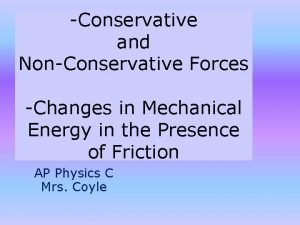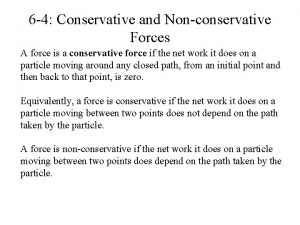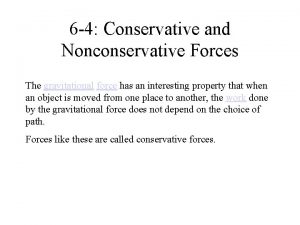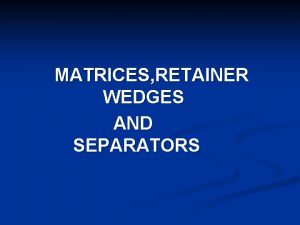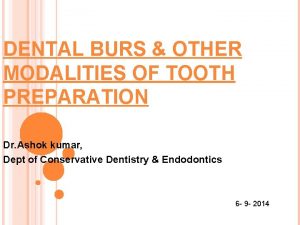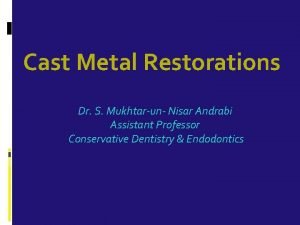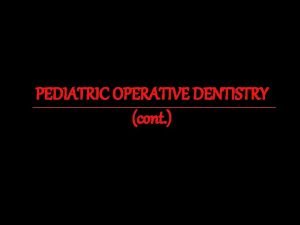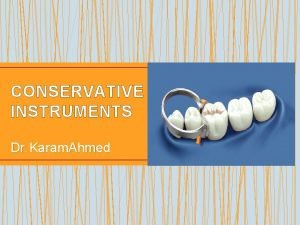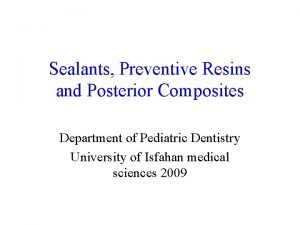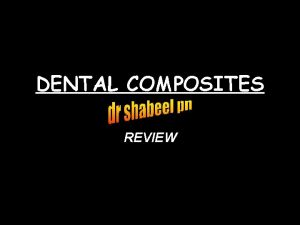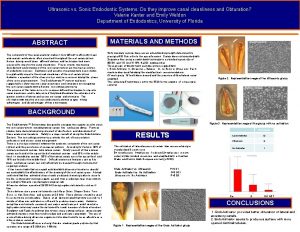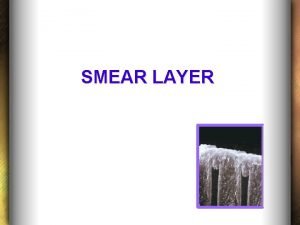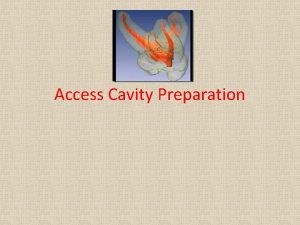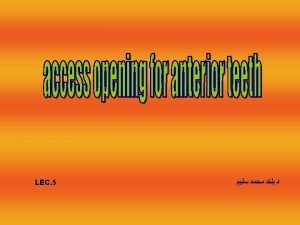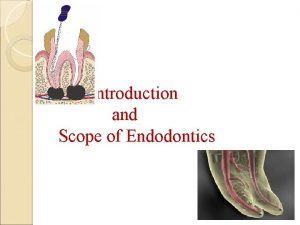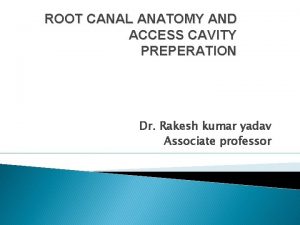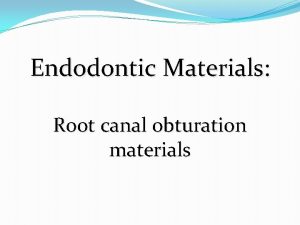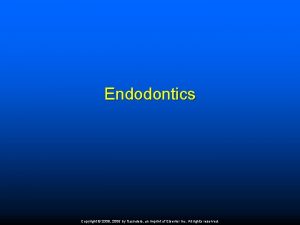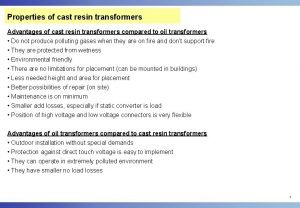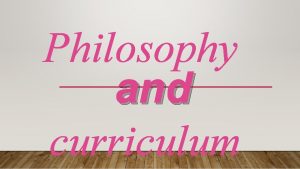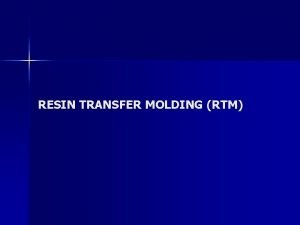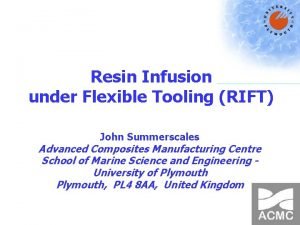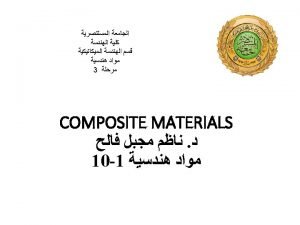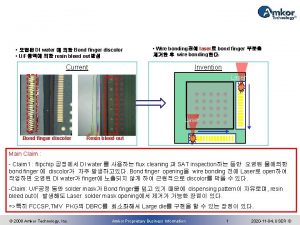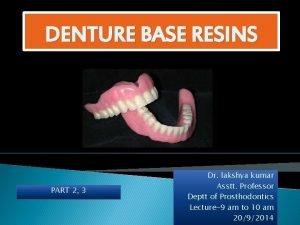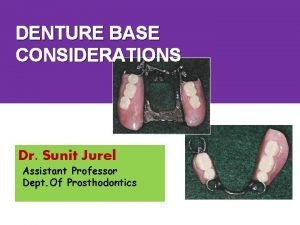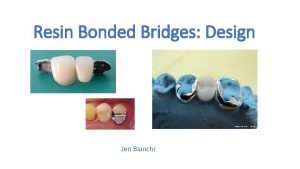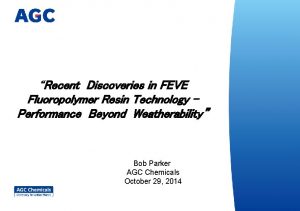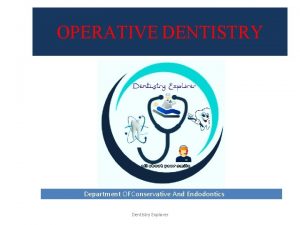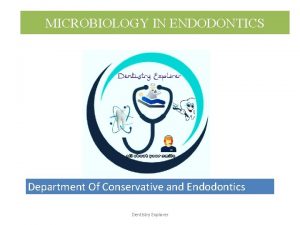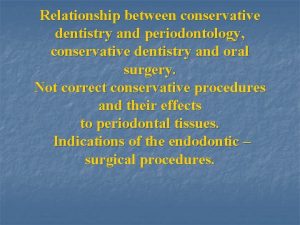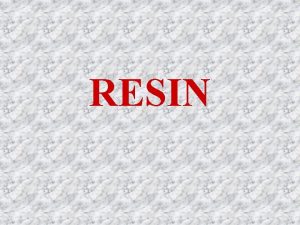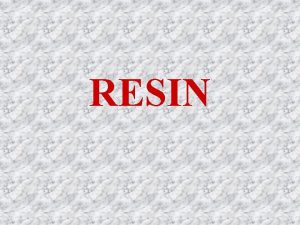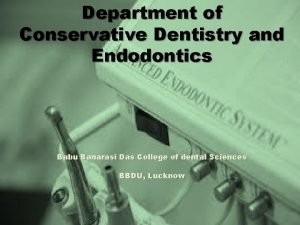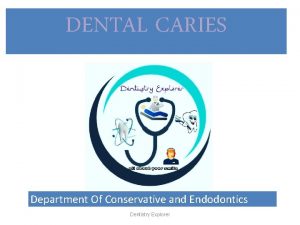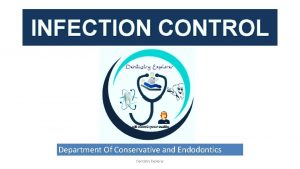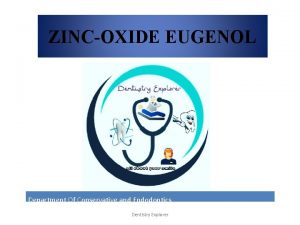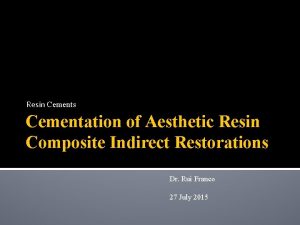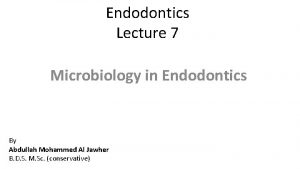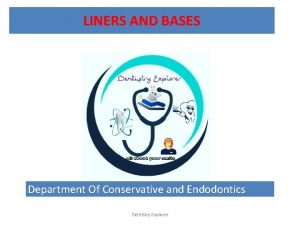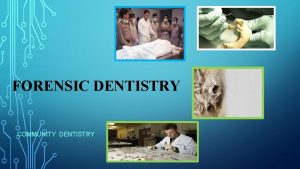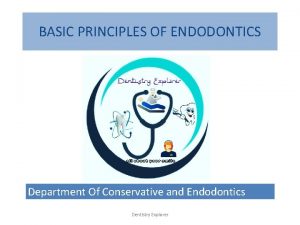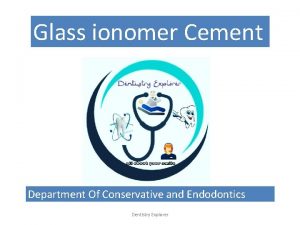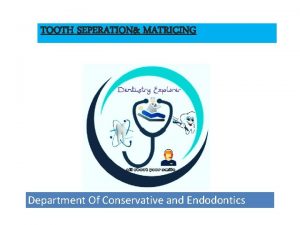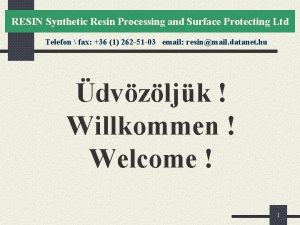Composite resin Department Of Conservative and Endodontics Dentistry









































- Slides: 41

Composite resin Department Of Conservative and Endodontics Dentistry Explorer

Dentistry Explorer

contents • General consideration for composite restoration • Indication • Contraindication • Advantages • Disadvantages • Clinical technique • Initial clinical procedure • Tooth preperation for restoration • Adhesion technique • Restorative technique for composite restoration Dentistry Explorer

CONTRAINDICATIONS: - 1. High caries incidence and poor oral hygiene. 2. Teeth with heavy or abnormal Occlusal stress. 3. If access & isolation difficulties. 4. Subgingival difficulties 5. Patient allergic or sensitive to resin composite. Dentistry Explorer

ADVANTAGES: 1. Esthetic. 2. Conservation of tooth structure. 3. Insulative. 4. Bonded to tooth structure. 5. ”Command set” 6. Repairable. 7. Can be polished at the same appointment Dentistry Explorer

Clinical technique of composite restoration A. Initial clinical procedures, B. Tooth preparation for composite C. Restorative technique for composite Dentistry Explorer

Clinical technique A-Initial clinical procedures, -Local anesthesia - patient is more relaxed - reduced salivation -Preparation of operating site – clean the operating site with slurry of pumice to remove any debris, plaque , pellicle, and superficial stains. Calculus removal Prophylaxis pastes containing flavoring agents, or fluorides act as contaminants and should be avoided to prevent a possible conflict with the acid-etch technique. Dentistry Explorer

Shade selection Color varies with translucency, thickness of enamel and dentin, age of the patient, presence of any external or internal stains Different color zones are present incisal third is lighter and translucent than cervical third. Middle third is blend of two Dentistry Explorer

1. Determine shade at the start of an appointment (before the tooth is subjected to dehydration) 2. Use either natural light (not direct sunlight) or a colour corrected artificial light source. 3. Drape the patient with a neutral colored cover if clothing is bright 4. Make rapid comparisons with shade tabs (no more than 5 seconds each viewing) Make the selection rapidly to avoid eye fatigue Dentistry Explorer

Automated Shade Selection Dentistry Explorer

Isolation of operating site - Rubber dam - cotton rolls - retraction cord Dentistry Explorer

B- Cavity designs for composite cavity preparation 1. Conventional 2. Beveled conventional 3. Modified 4. Box shape 5. Facial/lingual slot Dentistry Explorer

CONVENTIONAL similar to that of cavity preparation for amalgam restoration. A uniform depth of the cavity with 90° cavosurface margin is required INDICATIONS 1. Moderate to large class I and class II restorations 2. Preparation is located on root surfaces. 3. Old amalgam restoration being replaced Dentistry Explorer

BEVELED CONVENTIONAL 1. 2. Similar to conventional cavity design Have some beveled enamel margins. INDICATIONS 1. Composite is used to replace existing restoration. (class III, IV, V) 2. Restore large area Rarely used for posterior composite restorations Dentistry Explorer

• Advantage of enamel bevel-ends of enamel rods are more effectively etched producing deeper microundercuts than when only the sides of enamel rods are etched. Dentistry Explorer

MODIFIED 1. 2. 3. 4. 5. No specified wall configuration. No Specified pulpal or axial depth. All parameters determined by extent of caries. Conserve tooth and obtain retention (MICRO MECHANICAL). Scooped out appearance INDICATIONS small, cavitated, carious lesion surrounded by enamel correcting enamel defects. Dentistry Explorer

Dentistry Explorer

BOX ONLY PREPARATION • Indicated when only the proximal surface is faulty with no lesion present on the occlusal surface • Prepared with either an inverted cone or diamond stone held parallel to the long axis of tooth crown. • Initial proximal axial depth - 0. 2 mm inside DEJ. • Neither bevel nor secondary retention required. Dentistry Explorer

FACIAL OR LINGUAL SLOT 1. 2. 3. Lesion is proximal but access is possible through facial or lingual surface Cavosurface is 90 or greater. Direct access for removal of caries. Dentistry Explorer

Pulp protection In deep cavities pulp protection may be necessary prior to acid etching and bonding. - Calcium hydroxide, GIC , RMGI Zn. OE is contraindicated Dentistry Explorer

Adhesion ETCHING • 30 -40% conc. Of phosphoric used(ideally 37%) • For enamel & dentin for 15 sec and then rinsed off. • Available as –liquid and gel. Syringe for dispensing gel etchant Dentistry Explorer Applicator tip for liquid etchant

Etching Procedure Dentistry Explorer

ETCHING ENAMEL- • affects both prism core and prism periphery. • transforms smooth enamel into very irregular surface. • When fluid resin is applied to etched surface Resin penetrates etched surface Forms resin tags Basis for adhesion of resin to enamel Dentistry Explorer

ETCHING DENTIN • Affects intertubular and peritubular dentin. • Removes the smear layer and exposes collagen network to achieve optimal adhesion to the dentinal surface. • After rinsing the surface is kept slightly moistened when dentin is also involved because it allows the primer and adhesive material to more effectively penetrate the collagen fibre to form a hybrid layer which is the basis for mechanical bond to dentin. Dentistry Explorer

PRIMER or CONDITIONERS • Primers condition the dentin surface, & improve bonding. • Acidic in nature • eg. EDTA, nitricacid, Maleic acid Functions: • Removes smear layer & provides subtle opening of dentinal tubules. • Provides modest etching of the inter-tubular dentine. Dentistry Explorer

Bonding agents • Classified : Ø First generation(1980) – used glycerophosphoric acid dimethacrylate provide a bifunctional molecule. disadvantage – low bond strength. Eg-NPG-GMA Ø second generation (1983)-adhesive agents for composite resin. bond strength three times more than before. disadvantage-adhesion was short term the bond eventually hydrolysed. Eg. prisma , universal bond, clearfil, scotch bond Dentistry Explorer

ØThird generation – coupling agent had bond strength to that of resin to etched enamel. Disadvantages-use is more complex & require 2 -3 application steps eg-tenure , scotch bond 2, universal bond ØFourth generation-all bond-2 system consists of 2 primers(NPG-GMA and bisphenol dimethacrylate (BPDM) & an unfilled resin adhesive (40% BISGMA, 30%UDMA, 30%HEMA) ØFifth generation-single bond adhesive. advantage- single step application eg. 3 M single bond , one step (BISCO) Dentistry Explorer

Application of Bonding Agent: Application of the bonding agent and then cured for 10 seconds. Dentistry Explorer

Uses of bond Agents • For bonding composite to tooth structure. • Bonding composite to porcelain and various metals like amalgam, base metal and noble metal alloys. • Desensitization of exposed dentin or root surface. • Bonding of porcelain veneers. Dentistry Explorer

CURING • Two types: - 1. Self curing 2. Light curing. SELF CURING: not used extensively. Disadvantages 1. Mixing of two pastes required and it is almost impossible to avoid incorporation of air bubbles. Air bubble contain oxygen that causes oxygen inhibition during polymerization. 2. No control of working time. Dentistry Explorer

LIGHT CURING • Material inserted in tooth preparation in 1 -2 mm thickness. This allows the light to properly polymerize the composite and may render the effect of polymerization shrinkage appear along the gingival floor. • ADVANTAGES 1. Sufficient working time. 2. Not sensitive to oxygen inhibition. 3. Easy placement. LIMITATION 1. Time consuming Dentistry Explorer 2. Shrink towards the light source.

Curing Of the Composite: The material is cured using the light curing machine for 20 seconds for every increment of composite that was placed. Dentistry Explorer

Matrix placement • Two types of matrices are available - Polyester matrix - metal matrix • - Various matrix retainer which can be used are Tofflemire retainer Compound supported metal matrix Sectional matrix system- palodent contact matrix Dentistry Explorer

Dentistry Explorer

Dentistry Explorer

• Polyester matrix - used especially CLASS III, CLASS IV , CLASS V cavities Advantage - they allow the light to pass Disadvantage - they are not rigid and get deform during placement of rigid material and contact cannot be properly restored • Metal matrix - Ultrathin metal matrices. 001 -. 002 inch are used - Band should be precontoured outside the mouth Dentistry Explorer

CONTOURINGCan be initiated immediately after light cured composite have been placed or 3 minutes after the initial hardening of self cured material. POLISINGDone with fine polishing discs, fine rubber points or cups. Dentistry Explorer

Finishing and Polishing: The use of polishers with enhancers and polishing paste were done after the trimming of the excess composites. Dentistry Explorer

Finish & polish Tungsten carbide finishing bur is used to contour the marginal ridge (note the water spray). Rugby ball’-shaped fine diamond is used to contour the occlusal anatomy. All high-speed instruments must be used with water spray. A flexible, abrasive, impregnated disc is used to polish and smooth the occlusal contours. Dentistry Explorer

Composite restorations are very technique sensitive so utmost care is necessary before, During and after manipulation. The Visible Modes Of Failures 1) Discoloration-Especially At Margins 2) Marginal Fracture 3)Recurrent Caries 4) Post Operative Sensitivity 5) Cross Fracture Of Restoration 6) Lack Of Maintaining Contact 7) Accumulation Of Plaque Around The Restoration Dentistry Explorer

Thank You Dentistry Explorer
 Conservative forces examples
Conservative forces examples Force conservative et non conservative
Force conservative et non conservative A motorcyclist is trying to leap across the canyon
A motorcyclist is trying to leap across the canyon Gravitational force is conservative
Gravitational force is conservative Classification of wedges in dentistry
Classification of wedges in dentistry Dental burs for cavity preparation
Dental burs for cavity preparation Skirt preparation in onlay
Skirt preparation in onlay Circumferential tie
Circumferential tie Isthmus dental definition
Isthmus dental definition Cleoid discoid carver uses
Cleoid discoid carver uses Preventive resin restoration indications
Preventive resin restoration indications Classification of dental composites
Classification of dental composites Ultrasonic vs sonic
Ultrasonic vs sonic Douglas fir modulus of elasticity
Douglas fir modulus of elasticity Smear layer composition
Smear layer composition Enamel bevel definition
Enamel bevel definition Access cavity preparation grossman
Access cavity preparation grossman Lingual surface of anterior teeth
Lingual surface of anterior teeth Scope greek meaning
Scope greek meaning Creekside endodontics
Creekside endodontics Law of access cavity preparation
Law of access cavity preparation Endofill root canal sealer
Endofill root canal sealer Radio opaque
Radio opaque Modified double flare technique
Modified double flare technique Chapter 54 endodontics
Chapter 54 endodontics Cast resin transformer advantages and disadvantages
Cast resin transformer advantages and disadvantages The oldest and most conservative educational philosophy
The oldest and most conservative educational philosophy Physics 03-01 work and the work-energy theorem
Physics 03-01 work and the work-energy theorem Ideology
Ideology Conservative policies under reagan and bush
Conservative policies under reagan and bush Rink amide resin cleavage
Rink amide resin cleavage Light resin transfer molding
Light resin transfer molding Vacuum infusion london
Vacuum infusion london Composit
Composit Resin application server monitoring
Resin application server monitoring Flexera resin
Flexera resin Hard translucent fossil resin
Hard translucent fossil resin Laser bonding
Laser bonding Denture base parts
Denture base parts Primary disadvantage of cast metal base
Primary disadvantage of cast metal base Resin bonded bridge design
Resin bonded bridge design Feve resin
Feve resin

